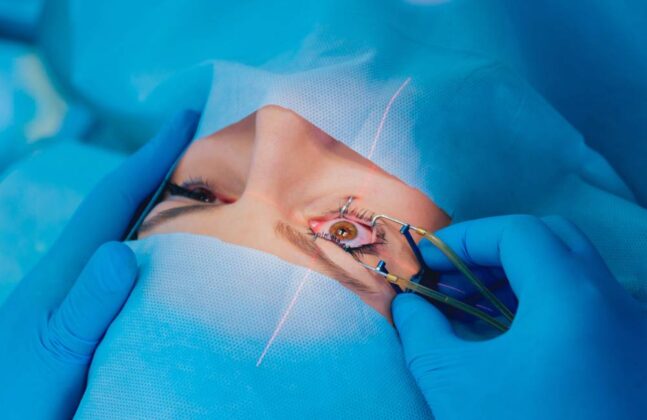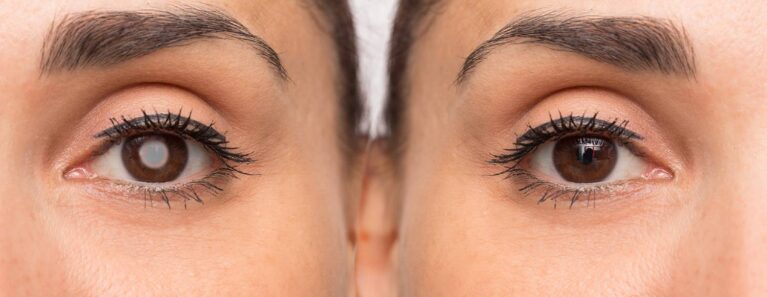Have you recently undergone cataract surgery but are still experiencing issues with your vision or the lens inserted into your eyes? You might be wondering if it’s possible to replace the lens after the procedure. Well, the answer is YES, it is possible to replace the lens after cataract surgery, but there are important considerations and timing factors involved.
In this blog, we’ll walk you through “why you might need an IOL exchange”, the “ideal time frame for the procedure“, and “the steps involved“.
If you’re struggling with your current IOL, don’t worry—there are options available to help you get the best possible outcome from your cataract surgery. Let’s dive in and explore how an IOL exchange can improve your vision.
Contents
Reasons You Might Need an IOL Exchange

While cataract surgery generally results in improved vision, there are several reasons why you might need to replace the Intraocular Lens (IOL) after the procedure. If you’re experiencing discomfort or unsatisfactory vision, an IOL exchange might be the solution. Here are the most common reasons why patients opt for this procedure:
Incorrect Lens Power Calculation
- One of the most common reasons for needing an IOL exchange is when the lens implanted during cataract surgery has the wrong power. This can lead to blurred vision or difficulty seeing at certain distances.
- If the spherical power is incorrect, the patient may need an exchange to correct the issue.
- In some cases, minor differences in lens power (e.g., 0.5D–3D) can be corrected with laser vision correction or add-on lenses, avoiding the need for a full lens replacement.
Mismatched Lens Design
- Some patients may receive different types of lenses in each eye, such as a monofocal lens in one eye and a multifocal lens in the other. This mismatch can cause discomfort and visual disturbances.
- A lens exchange is needed to replace the mismatched lenses and ensure both eyes have the same type of lens for better vision and comfort.
Patient Dissatisfaction with the Lens Type
- Many patients may not be fully aware of the different IOL options available, such as multifocal, extended depth of focus (EDOF), or trifocal lenses. After cataract surgery, some may realize they want to upgrade to a different lens type to improve their vision or reduce the need for glasses.
- Common complaints include glare, halos, or other visual disturbances, especially with multifocal lenses.
Poor Lens Positioning
- If the IOL is tilted, misaligned, or dislocated, it can cause vision problems and discomfort. This improper positioning of the lens may occur due to complications during the initial surgery.
- In such cases, the lens exchange can help by repositioning or replacing the lens to improve vision and comfort.
Complications from Initial Surgery
- If the capsular bag (the structure holding the IOL) was damaged during the initial cataract surgery, the IOL may have been placed in an alternative location, such as the anterior chamber or as an iris-fixated IOL.
- These alternatives may cause long-term problems, and replacing the IOL with a more stable option, such as a scleral-fixated or glued IOL, may be necessary for better stability and vision.
So, there are several reasons why an IOL exchange might be needed after cataract surgery, and if you’re experiencing any of these issues, it’s worth consulting with your eye specialist to determine if an exchange is the right solution for you.
When Should an IOL Be Replaced After Cataract Surgery?
The timing is very important if you need to replace the lens after cataract surgery. Here’s why early replacement is recommended:
The ideal time frame:
- Within 3 months of cataract surgery is the best time for the replacement.
- Early replacement ensures that the lens is still loosely settled in the capsular bag, making removal easier and safer.
Why Early Replacement?
- Post 3 months, the IOL becomes more firmly fixed in place, which can make removal more challenging and increase the risk of complications.
- Replacing the IOL within 3 months minimizes risks and leads to a smoother recovery.
Symptoms of a Dislocated Lens After Cataract Surgery
If the Intraocular Lens (IOL) becomes dislocated after cataract surgery, you may experience the following symptoms:
- Blurry or Distorted Vision
- Double Vision (Diplopia)
- Difficulty Seeing Clearly at Certain Distances
- Glaring or Halos Around Lights
- Sudden Decrease in Vision
- Visible Shift in the Position of the IOL (may be noticed during an eye exam)
- Eye Pain or Discomfort
If you notice any of these symptoms, it’s important to consult your eye specialist for evaluation and possible IOL repositioning or replacement.
How Is the IOL Exchange Procedure Performed?
An IOL exchange is a relatively straightforward procedure, typically done under local anesthesia. Here’s a quick breakdown of how it’s performed:
- Eye Examination: Your doctor will assess your eye health and the position of the current IOL to determine the best course of action.
- Anesthesia: The procedure is usually done under local anesthesia, numbing the eye to prevent discomfort during surgery.
- The surgeon will carefully make a small incision in the eye to access the lens.
- The dislocated or incorrect IOL is gently removed from the capsular bag or alternative placement site.
- A new Intraocular Lens (IOL), with the correct power and design, is carefully inserted into the capsular bag or an alternative location.
- The surgeon ensures the lens is properly positioned and secured.
- The incision is small and usually self-sealing, so stitches may not be required. The surgeon will ensure the eye is secure and well-positioned for healing.
- You will be given eye drops to prevent infection and inflammation.
Are There Risks and Complications of Lens Exchange?
Like any surgery, IOL exchange carries some potential risks and complications. However, these are rare, and the procedure is generally safe when performed by an experienced surgeon. Here’s a look at the possible risks and how to minimize them:
- Infection
- Increased Intraocular Pressure
- Retinal Detachment
- Dislocation of the New IOL
- Capsular Rupture
- Glare, Halos, or Visual Disturbances
- Dry Eye Syndrome
While the risks are manageable and relatively rare, it’s important to be informed and consult with your eye specialist to ensure the best outcome.
Conclusion
If you’re struggling with blurred vision due to cataracts and are considering an IOL exchange or cataract surgery, EyeMantra can help restore your clear vision. Our experienced specialists provide advanced treatment options to ensure the best possible outcome for your eye health.
If you’re experiencing cataract-related problems, Cataract Surgery at EyeMantra can help: Book your free appointment now at +91 9711116605.



